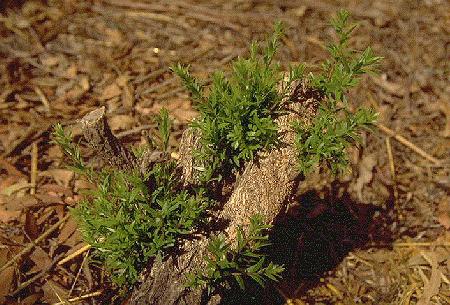
Pruning Australian Plants
Diana Snape
Deciding whether a certain Australian plant needs pruning can cause misgivings; even when you have decided 'yes' two more questions arise - 'when?' and 'how much?'. There are some general rules that can be helpful in answering these questions. In some cases the initial answer is quite obvious - if the plant is getting too big for the available space, if it's overgrowing other plants that are more important, or if it's becoming sparse and unattractive itself - in cases like these, it has to be pruned.
The 'when?' is probably straight away. This is often the answer, because once you have noticed a plant needs pruning, the time of year can seem almost irrelevant. It's probably better to do it then and there rather than risk leaving it and maybe forgetting or being unable to do it at a better time. 'After flowering' is an accepted rule but, even if you miss one year's flowering, no lasting harm is done. Times to hesitate might be either just before the winter's cold in a frost-prone area, or before the hottest days of summer. Tender new growth is vulnerable and you might want to avoid any setback, though reducing the mass of foliage before summer can reduce heat stress.
'How much?' has various answers. Some genera such as callistemons and melaleucas can tolerate severe pruning back into old wood. Others such as grevilleas often can't, although there are exceptions. In general, for any species, it's safer to look for small green shoots, or at least green leaves at axils, to cut back to. Shape the bush at the same time, pruning to where the shoot will grow outwards or in a direction which will improve the shape of the bush. If you want a formal look, cut back evenly to a formal shape. If you prefer a more natural appearance, cut some branches back lightly, some more heavily.
 |
Vigorous new growth arising from the trunk
of a severely pruned Callistemon |
If an old plant looks miserable and must be pruned, I would follow the good advice (and attitude) a friend gave me many years ago; prune it severely, even into hard wood. If it recovers, excellent. If it dies, put in a lovely new plant - the old one is no loss.
Not all mature plants need pruning - if size, shape and density are pleasing from year to year, spare the (sharp) secateurs. In addition, pruning may not help a plant achieve a more compact form if it's growing in shade when it really prefers full sun. Beautiful young plants pose a challenge to the would-be pruner too. However, early tip pruning can be important in determining the plant's structure in later life, helping keep its major branches relatively close together rather than widely spaced. So tip pruning is recommended for this purpose, pinching out the leading shoot (or shoots) from an early age, even straight after planting.
Fast-growing plants such as acacias will respond well to pruning each year, following the formula one third (of the branches) by one third (of their length). Some eucalypts and banksias can even be 'pruned' or coppiced back to ground level because they have lignotubers from which new branches will grow. In the natural environment, fire, storms, wind, drought, frost, insects and marsupials do the pruning, so our plants are accustomed to it. To maintain healthy, attractive Australian plants, we also need to prune!
From the newsletter of ASGAP's Garden Design Study Group, February 2007.
Australian Plants online - 2008
Association of Societies for Growing Australian Plants
|